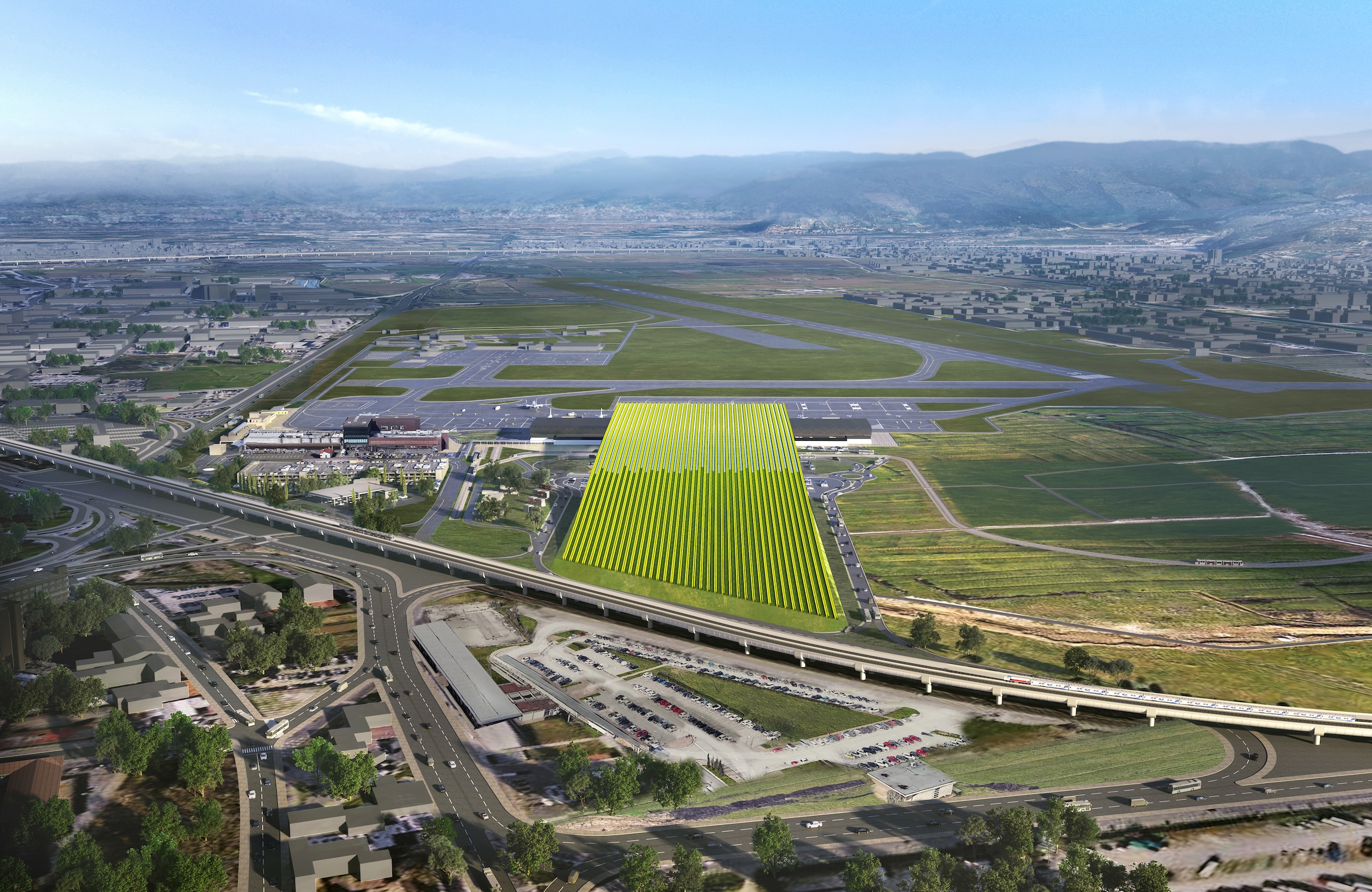At Florence, Italy’s Aeroporto Amerigo Vespucci, the new international airport terminal will feature a fully operating vineyard on the facility’s rooftop. Designed by Rafael Viñoly Architects, the terminal is expected to see over 5.9 million passengers annually. Renderings for the project have recently been released.
The 538,195-sf terminal project will involve both lengthening the existing runway and reorienting it 90 degrees away from the nearby hills, which have limited the operations of many modern planes.
The airport design aims to create a sense of place and improve the passenger experience. In the skylit terminal, arrivals and departures will face each other across a large, central public space, the Piazza. This organization will help streamline circulation into and out of the terminal.
In addition, the terminal will provide access to mass transit, parking, and retail, which will serve both travelers and the local community. The terminal will be connected to the city and the wider region by multimodal transport options, including a new light rail system.
A distinctive feature of the project is a 19-acre vineyard rising above the terminal. This will include 38 active vineyard rows on the building’s sloping roof—contributing to LEED Platinum sustainability rating and representing Italy’s winemaking tradition. A leading winegrower from the region will cultivate the vineyards, and the wine will be crafted and aged in special cellars located beneath the terminal’s roof.
The airport terminal will be completed in two phases: Phase one is expected to be finished in 2026, phase two in 2035.
On the Building Team:
Owner: Toscana Aeroporti SpA
Design architect and architect of record: Rafael Viñoly Architects
MEP engineer: Tekne SpA
Structural engineer: Eckersley O’Callaghan (EOC)
General contractor: Toscana Aeroporti Construction (TAC)






Related Stories
| Jul 18, 2014
Engineering firms look to bolster growth through new services, technology [2014 Giants 300 Report]
Following solid revenue growth in 2013, the majority of U.S.-based engineering and engineering/architecture firms expect more of the same this year, according to BD+C’s 2014 Giants 300 report.
| Jul 18, 2014
Top Engineering/Architecture Firms [2014 Giants 300 Report]
Jacobs, AECOM, Parsons Brinckerhoff top Building Design+Construction's 2014 ranking of the largest engineering/architecture firms in the United States.
| Jul 18, 2014
Top Engineering Firms [2014 Giants 300 Report]
Fluor, Arup, Day & Zimmermann top Building Design+Construction's 2014 ranking of the largest engineering firms in the United States.
| Jul 18, 2014
Top Architecture Firms [2014 Giants 300 Report]
Gensler, Perkins+Will, NBBJ top Building Design+Construction's 2014 ranking of the largest architecture firms in the United States.
| Jul 18, 2014
2014 Giants 300 Report
Building Design+Construction magazine's annual ranking the nation's largest architecture, engineering, and construction firms in the U.S.
| Jul 7, 2014
7 emerging design trends in brick buildings
From wild architectural shapes to unique color blends and pattern arrangements, these projects demonstrate the design possibilities of brick.
| Jul 2, 2014
Emerging trends in commercial flooring
Rectangular tiles, digital graphic applications, the resurgence of terrazzo, and product transparency headline today’s commercial flooring trends.
| Jun 30, 2014
Arup's vision of the future of rail: driverless trains, maintenance drones, and automatic freight delivery
In its Future of Rail 2050 report, Arup reveals a vision of the future of rail travel in light of trends such as urban population growth, climate change, and emerging technologies.
| Jun 18, 2014
Arup uses 3D printing to fabricate one-of-a-kind structural steel components
The firm's research shows that 3D printing has the potential to reduce costs, cut waste, and slash the carbon footprint of the construction sector.
| Jun 12, 2014
Austrian university develops 'inflatable' concrete dome method
Constructing a concrete dome is a costly process, but this may change soon. A team from the Vienna University of Technology has developed a method that allows concrete domes to form with the use of air and steel cables instead of expensive, timber supporting structures.

















